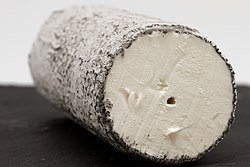Homemade Smoked Provolone Cheese
What is Provolone ?
Pronounced: proh-voh-LOH-nee
If you can imagine mozzarella with a fuller flavor, then you have imagined Provolone. It is a semi-hard Italian cheese, aged for a minimum of six months, and originated in Casilli near Vesuvius where it is still produced in various shapes as in 10 to 15 cm long pear, sausage, or cone shapes. A variant of Provolone is also produced in Japan and North America.
Smoked cheese makes a wonderful addition to sandwiches. Now, you can create this great taste with the step-by-step instructions for the best homemade smoked provolone cheese.
Ingredients:
- 4 gallons of raw goats milk
- 1 teaspoon of type K or KL lipase powder dissolved into 1/3 cup of cool, non-chlorine water
- 4 teaspoons of citric acid powder dissolved in 3/4 cup of cool, non-chlorine water. Allow this to sit for 5 minutes or more.
- 1 teaspoon of rennet mixed in 1/4 cup of cool, non-chlorine water
Instructions making the Provolone Cheese
- Warm 2 gallons of the milk to 86 degrees F
- Mix in the dissolved lipase powder.
- Keeping temperature at 86 degrees F, let milk set for 1 hour to incubate.
- Add the dissolved citric acid to the remaining 2 gallons of cold goats milk. Then, add the cold milk to the 2 gallons of warm milk and bring the temperature to 86 degrees F.
- Add the dissolved rennet to the combined 4 gallons of milk.
- Allow to sit for 15 minutes or more. Whey will cover the top of the curds.
- Now you are ready to cut the curds into 1/2 inch cubes.
- Allow curds to settle to the bottom of the pot, and then slowly raise the temperature to 115 degrees during a 30 mins time frame while stirring.
- And now, using a large dipper or stainless pot with a handle, remove the whey from the curds that have settled to the bottom of the pot. Leave enough whey to cover the matted curds.
- Prepare ice water in a pan long enough for the desired length of your provolone cheese log.
- Meanwhile, heat the whey that is covering the provolone log that you have begun shaping. Use a cloth that you drained the curds into to turn the log of provolone in the heated whey. Remove the heated whey and the provolone cheese log from the heat. Continue to lift the cloth to aid in shaping the log of cheese.
- When cheese becomes smooth and firm enough to handle, place the cheese into the ice water. Avoid handling the cheese log as much as possible.
- Do not rush the cooling process! If you have a wooden mold 3″x3″ and 10″ long, place the cheese log into the mold. After the cheese log chills, remove and rub with iodine free salt and cover with plastic wrap. Place in refrigerator at 45 degrees and redress every two days for 8 or 10 days. If you are going to smoke the provolone cheese, do not uncover the cheese log.
- After 10 days, wipe the cheese with cool water and pat dry.
Smoking the Provolone Cheese
- Cold smoke your provolone cheese for approximately 4 hours. You can use small hickory chips, fresh from the woods or small sassafras twigs from sassafras trees.
- Cold smoking cheese and meat is simple and inexpensive.
- All you need is a clean metal bottomless garbage can and a soldering iron. Take an average size can of vegetables and partially cut the lid, leaving enough of the lid attached to close the can after filling it with wood chips. Be sure to remove the outside paper from the can, then wash and dry it.
- Use tin snips to cut a round slot in part of the lid to allow you to put the soldering iron into the can filled with wood chips. Fill the can with small hickory chips or small sassafras twigs and place soldering iron into the can. Place garbage can on gravel and place the can with chips and soldering iron just under the metal bottomless garbage can. If you have a smoker, it will also work just fine.
- And now, this is what makes it a cold smoker. Take a large box that will cover the top of your smoker and cut a hole in the bottom of the box, about a 6 inch diameter circle. Place the box on top of the smoker making sure that the box will receive all of the smoke. Place a rack a few inches above the bottom of the box and place this rack as far away from the 6 inch diameter hole as possible. This to allow the cheese to absorb the smoke and remain cool.
- After about 15 minutes, unplug the soldering iron. Check the cheese, and if the cheese is dripping, then remove the cheese, place in a plastic bag and refrigerate.
- Repeat the process until the cheese starts making a rind. The color of the cheese will have a slight yellow cast. Do not let the rind become too dried out and hard. Wax the cheese after it is smoked, so that other cheeses that are being aged do not become smoked. Age 6-8 months or more from date of being waxed.
Enjoy! The best Smoked Provolone Cheese.
More Hard Cheese Recipes , Check them out!
More related goat cheese recipes;

Fried Chevre Baked Chevre Spread




